Somehow it seems wrong that no one has posted on this rather important little genus...
I don't have pictures of Eritrichium pauciflorum on this computer...I will post on that some time. It was the universal forget me not of the Mongolian mountains that grew by the thousands in all manner of turf and meadows, screes and tundra..I did get quite a bit of seed of it and shared it with some alpine nurseries. I have a fantasy it will be an easy alpine.
But for us in Denver, Eritrichium howardii is the one of choice: up by Choteau and here and there on the Great Plains of Montana (in a climate very similar to Denver) this grows thickly in the sparse grasses. Roy Davidson wrote of one locality where it was virtually the only thing growing for miles where cattle were browsing: he wondered if it was their fodder?
This clump has graced this trough for almost ten years, petering out a bit one year, and coming back the next. It has produced a finer display of bloom, but this is all I have on hand right now...so you must settle for it!

Comments
Peter George
Re: Eritrichium howardii
Sun, 05/30/2010 - 5:28pmI grew two plants from seed a few years ago, and after I planted them out, they overwintered and flowered the next year, and then came 19 days of rain. They didn't survive. The next year I placed seed directly in the open garden, and this year, three years later, I have 3 rather nice little plants which have bulked up considerably but which don't show any indications of flowering yet. Having survived two winters, I'm optimistic that I'll get some flowers next summer. It's a beautiful plant and flower, and one we don't see very often here in New England.
Panayoti Kelaidis
Re: Eritrichium howardii
Sun, 05/30/2010 - 8:52pmIf it's made it three years for you, it's a keeper. This is usually a Great Plains species that has to put up with great extremes (including periods of wetness). The plant in the picture has persisted over ten years for me...this is the Eritrichium for gardens: I've collected seed in the wild but never seen it in full glory. A friend in Montana just sent me pictures (it's blooming there now)...wouldn't that be fun!
Todd Boland
Re: Eritrichium howardii
Mon, 05/31/2010 - 3:28pmI grew these from NARGS seed this year...ended up with Lindelofia longifolia! Oh well, at least its in the same family...but really, how could a person mistake one for the other?!
Lori S. (not verified)
Re: Eritrichium howardii
Tue, 06/01/2010 - 11:33amI dunno, Todd... the darnedest things can happen in seed exchanges and trades!
I bought a little locally grown E. howardii at last year's alpine plant sale and it bloomed modestly in a trough this spring.
Lori S. (not verified)
Re: Eritrichium howardii
Wed, 06/02/2010 - 8:57pmSince Panayoti mentioned it in his initial message, perhaps it's apropos to show some seedlings of Eritrichium pauciflorum ssp. sajanense, grown this spring?
The seeds were from Pavelka, and the provenance and plants described as follows: "2000m, Sajan Mts., Russia; dwarf compact cushions, silvery-grey leaves, big blue flowers on scapes 4-10cm, stoney slopes, 2007 seed". Germination was delayed in room temp conditions, so I chucked them in the cold room for a month, after which there was good germination. Here are a couple of them snuggled into the new tufa bed.
Panayoti Kelaidis
Re: Eritrichium howardii
Thu, 06/03/2010 - 4:17amVery interesting, Lori: just realized I collected a ton of seed and shared it with several growers and need to check up on my own seedpots...
Michael Peden
Re: Eritrichium howardii
Sat, 07/07/2012 - 8:27amPhoto taken at end of June 2012 in my garden. The seed of this Eritrichium was collected just south and east of Ima Mine, above Patterson Creek, Idaho, on cold alpine tundra in 2009. The leaf blade appears to be narrow as in E. howardii, but, from my general observation, unlike the broader blade of E. aretioides as it is found on other mountain ranges (Bighorn;Wallowa). The cushion in nature is extremely congested. There appear to be flower buds: This plant already seems preparded for winter which won't come here for another five months! The second photo of the same plant was taken earlier in the season.
Lori S. (not verified)
Re: Eritrichium howardii
Sun, 08/19/2012 - 8:25amHere's Eritrichium howardii, bought from Beaver Creek this spring and (seemingly) happily ensconced in the tufa garden... so far, so good. :D
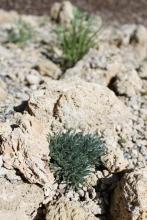
Mark McDonough
Re: Eritrichium howardii
Sun, 08/19/2012 - 2:04pmFine looking small cushion there, with howardii-esque looking narrow silver foliage. I bet (and hope) you'll be showing us photos of this plant in flower next year.
Lori S. (not verified)
Re: Eritrichium howardii
Sun, 08/19/2012 - 5:13pmI hope so too. The one I mentioned earlier that I had in a trough has since expired... :rolleyes:
Michael Peden
Re: Eritrichium howardii
Tue, 08/21/2012 - 4:07pmHere's my best E. howardii right now. Now to tune in to precise flowering conditions; collect tons of seed and start a strain that is resistant to pestilence and is easy to grow.
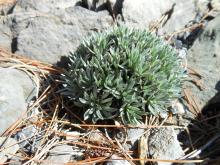
I pictured this one a few weeks back. I'm surprised how well it is handling our climate. It was snowing in August when I collected the seed (Lemhi Mountains)! Any flowers that were forming aborted.
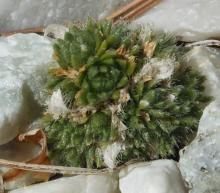
This one was grown from seed collected in the Wallowa Mountains in 2009. The Wallowa population produces lovely proportioned and large cushions, for the genus. It's a very pretty plant. It shares a wide leaf blade and hairiness with the next. The second photo was taken in April.
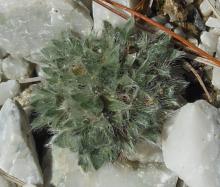
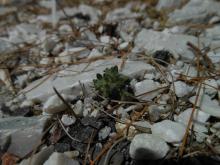
This one was collected in the Bighorn Mountains in 2009. This eastern form is the hairyest I know of. The rosettes are large but the tufts are small and parched looking even in habitat. It grows on west/southwest facing shale slopes that likely don't collect a lot of snow. The second photo was taken in April.
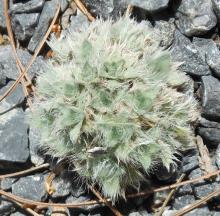
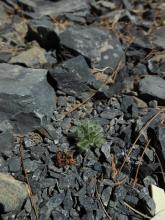
I hope to post all of these in glorious flower next year!
cohan (not verified)
Re: Eritrichium howardii
Sun, 08/26/2012 - 11:51amGreat bunch, Michael- very nice to see the variations!
Michael Peden
Re: Eritrichium howardii
Fri, 12/07/2012 - 6:40amHere's a mid December 2012 update on the Eritrichiums in the garden I posted previously; Eritrichium howardii (same age as others -2009 seed); E. ex Lemhi Mountains; E. ex Wallowa Mountains; and E. ex Bighorn Mountains.
Michael Peden, Dec. 6, 2012
Mark McDonough
Re: Eritrichium howardii
Fri, 12/07/2012 - 8:37amMichael, wonderful photos (and plants), in both seasons shown, but I am drawn to the fall/winter forms of plants as they prepare themselves for hibernation. Congrats on your success growing these treasures.
Longma (not verified)
Re: Eritrichium howardii
Fri, 12/07/2012 - 8:53amFantastic Michael, :o :o
Thoroughly enjoyed seeing your posts.
cohan (not verified)
Re: Eritrichium howardii
Fri, 12/07/2012 - 11:11amSo much variation, Michael! Worth growing just for the foliage forms...
Lori S. (not verified)
Re: Eritrichium howardii
Fri, 12/07/2012 - 2:08pmLooks like I forgot to return to this thread to post what Eritrichium pauciflorum ssp. sajanense looks like in bloom, so here it is. Two seedlings in different conditions; there is repeat bloom throughout the season.
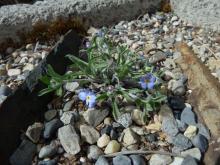
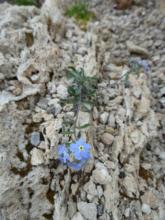
cohan (not verified)
Re: Eritrichium howardii
Fri, 12/07/2012 - 11:17pmDoes sajanense indicate a Russian species/form?
Lori S. (not verified)
Re: Eritrichium howardii
Sat, 12/08/2012 - 8:37amYes, presumably. The seeds were collected by Pavelka at 2000m in the Sajan Mts., Russia, according to his catalogue.
cohan (not verified)
Re: Eritrichium howardii
Sat, 12/08/2012 - 6:00pmThat's where I recognised the name Sajan from. lol- don't recall hearing of those mountains until looking at seedlists!
Trond Hoy
Re: Eritrichium howardii
Mon, 12/10/2012 - 1:47amIsn't the correct spelling in English Sayan? The Russian spelling is Саяны, and the letter я should be ya in English (ja in Norwegian though ;) )
Seems to be a remote place anyway.
cohan (not verified)
Re: Eritrichium howardii
Mon, 12/10/2012 - 11:29amI don't know, Trond- I only know it from Czech seed lists!
A very quick google search, and Britannica says: 'Sayan Mountains, also spelled Sajan or Saian' so I guess however you spell it, the pronunciation would be more english y than j.. this is an occasional habit in modern english- to keep non-english spelling, leading to great confusion for pronunciation ..lol
Mostly I consider this name a good sign, since I figure if plants are from mountains in Russia, they have a good chance of being hardy enough here!
Brian_W (not verified)
Re: Eritrichium howardii
Tue, 12/11/2012 - 1:31pmGreetings,
E. howardii is one of the most common plants where I live in Western Montana. Virtually every limestone outcrop is covered with them.
John P. Weiser
Re: Eritrichium howardii
Tue, 12/11/2012 - 5:07pmLovely photos Lori, Michael and Brian!!
To see them is to want them and I do!! :)
Lori S. (not verified)
Re: Eritrichium howardii
Tue, 12/11/2012 - 7:03pmWow, fantastic, Brian! Sounds like it is as common there as Myosotis asiatica (a similar colour at least) is here!
I dunno, Trond. The Plant List (if you like it or any of the other taxonomic efforts out there!) does show it as Eritrichium pauciflorum ssp. sajanense... but says it's a synonym of Eritrichium villosum.
http://www.theplantlist.org/tpl/record/tro-4002198
Trond Hoy
Re: Eritrichium howardii
Wed, 12/12/2012 - 10:34amLori, the name of the plant is one thing, the English name of the mountain another ;D
Lori S. (not verified)
Re: Eritrichium howardii
Wed, 12/12/2012 - 5:44pmYes, Trond. I see what you're saying:
I didn't even think to check that, I just referred to the collection locale as it was written in the seed list ("Sajan"). Geography is definitely not my strong suit!!
Richard T. Rodich
Re: Eritrichium howardii
Wed, 12/12/2012 - 9:48pmSo true:
omeiensis, omeiena, emeisensis, emeiensis ...
koreana, coreana, koraiensis ...
etc.
cohan (not verified)
Re: Eritrichium howardii
Thu, 12/13/2012 - 11:23amAs you can see from my post above, you can call it just about anything you want in English ;D
Brian- wonderful! I hope we'll be seeing a lot more of your natives :)
Trond Hoy
Re: Eritrichium howardii
Thu, 12/13/2012 - 12:21pmI came to think about something - do you say you speak English or Canadian in Canada? (Not talking about French . . . ) ;)
I have to say something of the Eritrichiums too! They are very beautiful plants, like some refined form of forgetmenot. However I have never tried to grow any assuming they'll dislike the humid climate here.
cohan (not verified)
Re: Eritrichium howardii
Thu, 12/13/2012 - 6:09pmThere are occasions when we need to specify what sort of English, since we do of course have some different usage than U.S., various parts of Britain, Aus, NZ etc, so then we will specify Canadian English, but normally we just say English...
Anne Spiegel
Re: Eritrichium howardii
Sat, 12/22/2012 - 5:08amPictured is Eritrichium howardii, which manages to get through our winters OK. It will never look as it does in the wild. but the great news is that it seeded itself into a piece of tufa, where it has persisted for three years but has yet to flower.
Lori S. (not verified)
Re: Eritrichium howardii
Sat, 12/22/2012 - 2:36pmIt looks wonderful, Anne, and self-seeding yet too. :o
cohan (not verified)
Re: Eritrichium howardii
Sat, 12/22/2012 - 3:09pmSelf perpetuating is extra good news, Anne :)
Michael Peden
Re: Eritrichium howardii
Fri, 02/01/2013 - 6:32amJanuary 31, 2013 update on Eritrichiums here. A day of record warmth for the date here (55F.) has melted all the snow that was covering these. E. howardii is showing full normal winter dormancy. There's probably some significance to the few yellow leaves. The dormant growing point appears purplish and the outer foliage is obviously dead. The Lemhi Mountains plant remains largely green. The Bighorn Mountains plant pictured has changed little since December despite its respite under the snow. Ditto the Wallowa Mountains plant (not shown).
Richard T. Rodich
Re: Eritrichium howardii
Fri, 02/01/2013 - 8:07amSo nice to document these differences, Michael!
Do they all have the same exposure?
Michael Peden
Re: Eritrichium howardii
Wed, 03/27/2013 - 3:19amEritrichium howardii (my garden) in late March 2013. They grow well in cool weather. It appears as if the flower buds begin in spring on these as opposed to fall, but I don't really know.
Anne Spiegel
Re: Eritrichium howardii
Wed, 03/27/2013 - 6:25amI think you're right, Michael. I've never noticed any bud-forming in the fall. Your plants looks really good. Follow-up pictures, please.
Michael Peden
Re: Eritrichium howardii
Wed, 03/27/2013 - 12:58pmYes, Anne, of course! I was out there just a minute ago and there has already been change in the plant since morning. I love rock gardening!
Merlin (not verified)
Re: Eritrichium howardii
Wed, 03/27/2013 - 7:36pmI used to grow E. howardii in a pot but have since focused on growing it in the open garden. we are a few weeks away from the garden plants flowering but here is one in a pot.

Anne Spiegel
Re: Eritrichium howardii
Wed, 03/27/2013 - 9:09pmThat is gorgeous.
Trond Hoy
Re: Eritrichium howardii
Thu, 03/28/2013 - 12:00amLooks good in a pot too ;)
Mikkelsen (not verified)
Re: Eritrichium howardii
Thu, 03/28/2013 - 8:36pmFantastic! What a glorious gem!
Lori S. (not verified)
Re: Eritrichium howardii
Sat, 04/27/2013 - 8:56pmEritrichium howardii seems to have wintered over well!
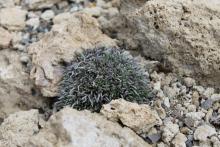
Michael Peden
Re: Eritrichium howardii
Thu, 05/09/2013 - 4:45pmEritrichium howardii in bloom. I recently fed this African Violet food (high in P) as part of its regime hoping to get a truly pumped up specimen. This may be risky down the line and I'm not sure it makes a big difference on bud set -timing still undetermined.
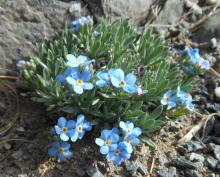
The Bighorn Mountains plant got the same dose. It actually had two blossoms at about the time I dosed it. Now it is definitely "out of character". I think this not necessarily bad for plants growing in the (relative) greenhouse that is the northeastern garden. Precise conditions/feed will do this wonders but perhaps I won't!
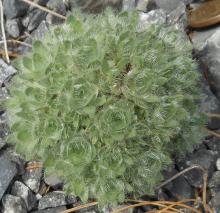
Eritrichium from the Wallowa. No intention of blooming. Ever? Note the minuscule bug at right in the photo: It is a pest of these; eating flowers and perhaps pollen. Mmmmm....blue candy....
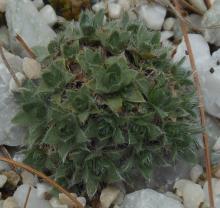
Eritrichium from the Lemhi Mountains: Oops! Hope Y'all didn't go up onto the land of eternal winter in search of the rare Eritrichium with the tiny leaves. The Drabas got me! This wouldn't be the first time a small collection packet (of mine) had more than one species put into it. Good odds that this extremely tiny growing Draba came from up there in August winter.
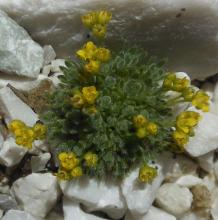
Bundraba!
Anne Spiegel
Re: Eritrichium howardii
Fri, 05/10/2013 - 8:19amMichael, do keep us up to date on your fertilizing experiment. I've never had the nerve to try it with this plant. My big eritrichium news is that E. howardii has made two new seedlings. I'll try taking a photo with a zoom. The seedling from two years ago is still there in a piece of tufa but no blooms yet.
Lori S. (not verified)
Re: Eritrichium howardii
Mon, 05/13/2013 - 7:15pmOkay, it wintered over and I see lots of buds tucked into those little rosettes... crossing my fingers... ;)
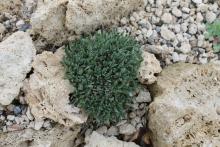
Anne Spiegel
Re: Eritrichium howardii
Tue, 05/14/2013 - 11:50amLori, it looks like a winner to be. Mine didn't flower as well as last year but since it made seedlings it can be forgiven anything. The others didn't flower at all but look good.
Trond Hoy
Re: Eritrichium howardii
Fri, 05/17/2013 - 12:29amSeems Eritrichums are the ultimate plant for a dedicated gardener to keep alive during the winter! Then I wont try - not at home anyway - but maybe I'll give them (and me) a chance at my mountain cabin! They are great plants ;)
Lori S. (not verified)
Re: Eritrichium howardii
Fri, 05/17/2013 - 7:14pmThe start of bloom, with many, many more buds to go! (I'll try not to be too big of a nuisance with these photos... :D)
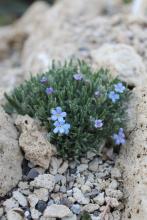
Pages